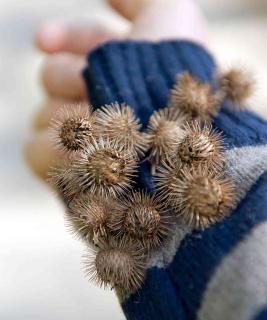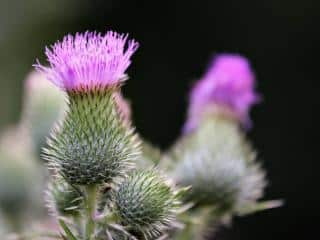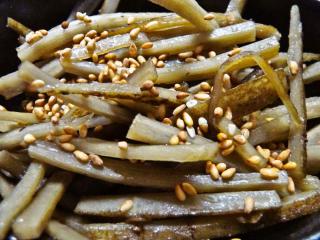

A biennial plant native to Asia, America and Europe (except for the Mediterranean region), burdock most often grows voluntarily on freshly turned plots of land,
along paths and even in abandoned vacant lots. It is very common in Quebec.
Burdock belongs to the aster family (Asteraceae), and can reach over 6 ½ feet (2 meters) in height. Its distinctive roots are fleshy and over 20 inches (50 cm) long. Purple or violet flowers bloom in bunches and bear strong barbs on their underside, large heart-shaped leaves develop at the tip of long petioles.

Indeed, “burdock” comes from:
The English name “burdock” thus connects to the notion of “clinging on” to passing beings.
In other languages such as modern French, burdock has names like “bardane” that originate from the word “barbe” meaning “hook”, and also “gratteron” which means “itchy”, because of its fruits that are clustered like a flail and their hooks that catch on to animal fur (cat or dog tails), clothes or hair.
Burdock is quite “intelligent” and spreads its seeds in 3 different manners:
– fruits dry on the stem, then open to spread seeds around,
– the fruit-bearing tip of the stem breaks off, and the clustered fruits are blown by the wind and disperse seeds as they roll around,
– fruits attach to animal fur, hair, or our clothes and travel great distances.
They can thus end up very far away from their native habitat, and since they are competitive plants, they invade other plant species in remote locations.
Animals such as donkeys, horses and zebras love this plant and have given it the name “donkey’s cabbage”. The massive size of its leaves led it to be called “giants’ ears” in some parts. But it also has more romantic names such as “love leaves” (because you can’t get rid of it), wild rhubarb, artichoke, clot-bur, herrif, beggar’s buttons and even “devil’s tobacco”!
In France, it also is called “Ringworm herb” (“herbe aux teigneux”, meaning “herb for those infected with ringworm scalp”)!
Whatever its name, this beneficial plant is known to be effective in treating chronic diseases related to the scalp and skin.

– detoxifying and purifying properties: burdock protects from skin conditions since it stimulates liver and kidney toxin-elimination functions.
– soothing properties help alleviate various types of inflammation and itchiness, including pain due to rheumatism, arthritis and the digestive tract disorders.
– in Europe, burdock is a medicinal with clearly defined properties: it is a diuretic, antibiotic, diaphoretic, anti-diabetic, antidotal, topical, choleretic.
“Ringworm herb” is used of course to treat ringworm, but also gout, anthrax, acne, measles, dermatitis, cutaneous or skin conditions, kidney stones, abscessed teeth and throats, wounds, viper bites, rheumatism, chronic pulmonary disorders, persistent colds, furunculosis and diabetes (thanks to its high inulin content).
As for burdock roots, once chopped and cooked, they can be used to treat anemia.
Used in infusions, capsules, powders, tinctures, decoctions, extracts, poultices, or ointments, applications of burdock in terms of health are numerous.
Today, burdock has become part of the organic beauty industry.
It fresh leaves are used to manufacture lotions for hair care since they avert hair loss.
– in oriental medicine, herbal tea made from burdock seeds helps treat exhaustion, digestive tract diseases (stomach cramps), breast tumors…
Burdock juice is known to treat appendicitis.

American Indians recently added cooked leaves or dried roots to their diets, prepared in soups.
However, in Japan, less bitter and much softer burdock varieties are eaten as vegetables, together with parsnip, carrot or salsify.
Note that burdock infusions can be drunk instead of coffee.
Once leaves and roots are collected and crushed, its is best to heat them in a vessel.
Afterwards, filter the resulting preparation with clean cloth, and use is as a poultice to treat skin disorders (psoriasis, dermatitis).
Against skin disorders such as acne or other cutaneous infections, prepare 0.05 to 0.08 oz (1.6 to 2.4 grams) of base tincture in a glass of water. Drink thrice a day.
Burdock extracts are recommended in dermatology. They appear in certain creams and lotions.
In infusions, recommended doses are 0.1 to 0.2 oz (3 to 6 grams) burdock roots and leaves per cup, in half a quart (half a liter) water. Let steep, and drink thrice a day.
This preparation can be ingested as a drink, or even spread on skin directly.
Once burdock roots have been cut, they oxidize very quickly.
This is why it is best to macerate root chunks in very cold water and let them sit for a few minutes.
For best results, following recommended dosages is critical.
If symptoms persist, consult your physician immediately.